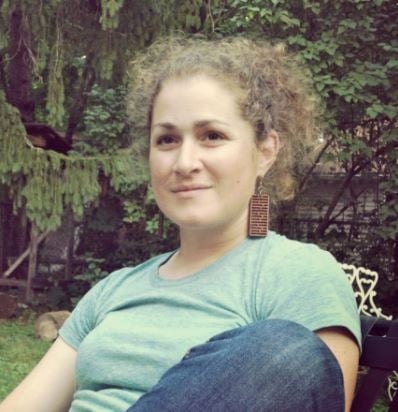Garden Crusader: Emily Posner
2006 Garden Crusader Award
 As Emily Posner watched the chaotic aftermath of Hurricane Katrina from her home in Portland, Maine, what she saw disturbed her deeply. "I had been working on food security, hunger, and environmental justice issues in Maine for years, but when I saw what was happening in New Orleans I knew I needed to go there to help," says Emily. What started as a temporary volunteer stint, has become a long-term commitment to helping New Orleans residents rebuild their neighborhoods and their lives.
As Emily Posner watched the chaotic aftermath of Hurricane Katrina from her home in Portland, Maine, what she saw disturbed her deeply. "I had been working on food security, hunger, and environmental justice issues in Maine for years, but when I saw what was happening in New Orleans I knew I needed to go there to help," says Emily. What started as a temporary volunteer stint, has become a long-term commitment to helping New Orleans residents rebuild their neighborhoods and their lives.
Relief Work
Emily wanted to work directly with people in need. On one of the many web sites about Katrina rescue efforts, she read about a grass-roots relief effort being spearheaded by Malik Rahim, a local New Orleans activist. Like most volunteers who showed up in the first few weeks, Emily started out in direct relief work. "At first I was doing a little of everything; fixing roofs, distributing food and supplies, helping people get medical attention," she says. As volunteers streamed in from around the country, a number of organizations formed to tackle different problems. One of these called itself the Common Ground Collective. Common Ground's mission is to provide short-term relief for the victims of Hurricane Katrina, and long-term support for rebuilding New Orleans communities. Common Ground volunteers are working in the hardest hit and poorest sections of New Orleans and in the Louisiana Bayou, in an effort to help people return to the city and to their lives.
Bioremediation Work
After a few months, Emily shifted her focus from relief work to rebuilding. "My inspiration was my friend, Meg Perry, who came down to New Orleans with me from Maine. Meg had become involved in the community gardens in New Orleans," says Emily. Tragically, her friend was killed in a bus accident in December of 2005, en route to a march in support of hurricane survivors. "In honor of Meg, Common Ground decided to name our bioremediation and gardening work, The Meg Perry Healthy Soil Project. I became deeply involved in the project to honor her and keep her passions and spirit close to my work," says Emily.
Bioremediation is the process of using living organisms to clean up polluted soil and water. The flooding from Hurricane Katrina left behind all sorts of toxic waste problems. The soil and waterways were polluted by chemicals from households, gas stations, dry cleaners and many other locations. In the Gert Town neighborhood, 55-gallon drums of pesticides were seen floating away from an abandoned pesticide plant. The toxins that have tainted the soil include heavy metals, diesel-range organics and polycyclic hydro-carbons and pesticides.
The Meg Perry Healthy Soil Project is growing plants in some of these contaminated soils to capture and remove toxins from the ground. "Certain plants have the ability to absorb these contaminants," says Emily. For example, she's been growing sunflowers to take up excess lead in soils around private homes and even public schools. "We're also using compost tea as a way to speed up the decomposition of these toxins," she says. "Soon we'll be trialing oyster mushrooms as another bioremediation tool. Oyster mushrooms can break down toxic materials very quickly in the soil," says Emily.
After the plants mature, Emily removes them and brings the plant material to a toxic waste dump. "Right now we're doing all the work, but we hope to establish training sessions so we can teach the residents how to use these plants themselves for cleaning the soil," she says.
Rebuilding Community Gardens
Before Katrina, the Gentilly Neighborhood of New Orleans had a thriving community garden and greenhouse. After the hurricane, all of that was destroyed. Emily and fellow volunteers have started working with Parkway Partners (a local organization that manages 60 community gardens in New Orleans) to rebuild the Sun Done Meg Perry Community Gardens in honor of her lost friend. "We've got the beds back under cultivation and hopefully we'll be doing some gardening with the residents of this neighborhood this winter, says Emily.
"In September 2005, New Orleans looked post-apocalyptic," she says. "But now there are signs it is coming back. People are slowly moving back into old neighborhoods and many are committed to reviving this diverse and historic city. "The city council is starting to help, even though in poor sections many houses still don't have running water and electricity," says Emily.
Emily doesn't know how long she will continue volunteering to help New Orleans get back on its feet, but she knows the benefits have gone both ways. "As much as I've helped the people here, I've learned so much about community building from the elders," she says. Emily's work in New Orleans is bringing people and plants together in powerful ways to help rebuild the city's social and environmental fabric.
Last updated: 11/14/2022
Print this Article:
Related Articles
Get the Dirt
Stay up to date on new articles and advice. Please fill out the information below.



